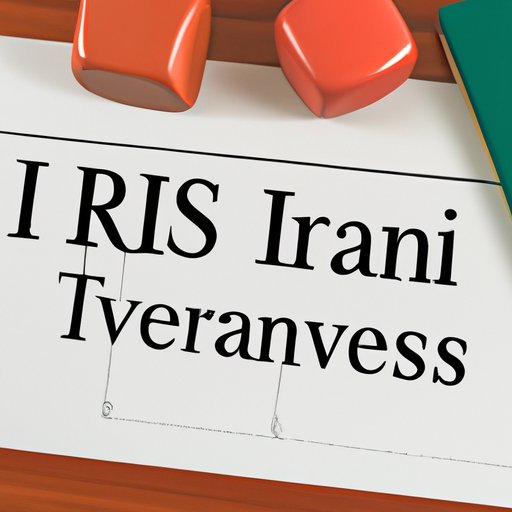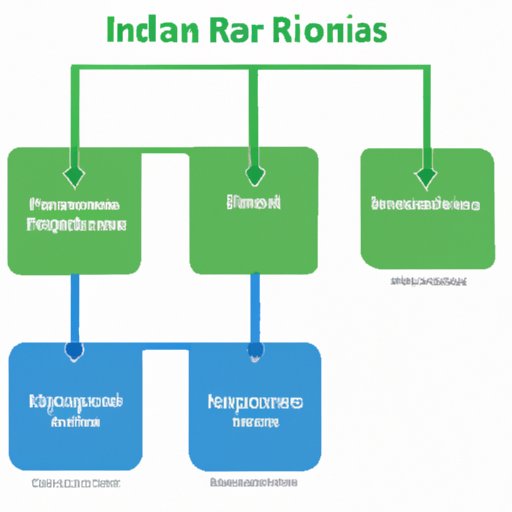
Introduction
An Individual Retirement Account (IRA) is a retirement savings account that offers tax benefits to individuals. Various types of IRAs allow you to invest in stocks, bonds, and other assets to generate returns. With an IRA, you can plan for retirement without relying solely on social security or a pension. Investing in an IRA helps you build wealth, maximize your returns, reduce your tax burden, and ultimately achieve your retirement goals.
Understanding the Basics of Investment
Before diving into the details of IRAs, it’s essential to understand the fundamentals of investment. Investment is the act of allocating money to get a return in the future. There are various types of investments, including stocks, bonds, real estate, and more. Each type has its unique features, benefits, and risks.
Investing has many benefits, but it also comes with some risks. As an investor, you need to assess your risk tolerance, diversify your portfolio, and maintain a long-term investment mindset. Investing can help you build wealth and achieve your retirement goals, but it’s essential to have a solid understanding of the risks involved.

A Guide to Different Types and Structures of IRAs
There are various types of individual retirement accounts to choose from. Each type offers its unique tax benefits and features, including contribution limits, eligibility requirements, and withdrawal rules. Here are some of the most common types of IRAs:
Traditional IRA
A Traditional IRA allows you to make contributions to your account on a tax-deductible basis. Your contributions and earnings grow tax-free until you withdraw them at retirement. At that point, you’ll pay taxes on your withdrawals at your ordinary income tax rate. Traditional IRAs are an excellent way to reduce your taxable income and save for retirement.
Roth IRA
A Roth IRA is an IRA that allows your investments to grow tax-free. You pay taxes on your contributions upfront, but your withdrawals at retirement are tax-free. Roth IRAs are a great option for individuals who believe they’ll be in a higher tax bracket at retirement or who want more flexibility with their withdrawals.
Simplified Employee Pension Plan (SEP)
A Simplified Employee Pension Plan (SEP) is a type of IRA designed for self-employed individuals and small business owners. Contributions are made by the employer on a tax-deductible basis. SEPs have higher contribution limits than traditional IRAs, making them an excellent option for individuals who want to save more for retirement.
Self-employed SEP
A Self-employed SEP is a type of IRA designed for self-employed individuals. It has the same features as a traditional SEP, but the contribution limits are based on your net profits from self-employment. Self-employed SEPs are an excellent way to maintain the flexibility of a traditional SEP while taking advantage of tax benefits as a self-employed individual.
Choosing the Right Type of IRA
Choosing the right type of IRA depends on your personal circumstances, investment goals, and tax situation. Traditional IRAs are an excellent option if you want to reduce your taxable income and pay taxes at retirement. Roth IRAs are ideal if you want to invest in tax-free growth and have more flexibility with your withdrawals.
SEPs and Self-employed SEPs are ideal for small business owners and self-employed individuals who want higher contribution limits and tax-deductible contributions. You can choose one or multiple types of IRAs based on your desired investment portfolio.
Investing in Stocks and Bonds with Your IRA
Investing in stocks and bonds is a popular way to generate returns with your IRA. Stocks and bonds have different features, benefits, and risks. Stocks represent ownership in a company, while bonds represent a loan to a company or government. These asset classes can provide diversification and help you achieve your investment goals.
Understanding Stocks and Bonds:
Stocks are generally riskier than bonds because their prices can fluctuate more significantly. However, they have higher potential returns over the long-term. Bonds tend to be more stable, but their returns are lower. A balanced investment portfolio will typically have a combination of both.
The Advantages and Disadvantages of Investing in Stocks and Bonds:
One advantage of investing in stocks is the potential for high returns. However, stocks are also risky and volatile. During a market downturn, your investments may suffer significant losses. Bonds are less risky but provide lower returns. Investing in both stocks and bonds can provide diversification and reduce the overall risk of your portfolio.
How to Invest in Stocks and Bonds with Your IRA:
To invest in stocks and bonds with your IRA, you’ll need to open an account with an IRA custodian or brokerage firm. You can then select individual stocks and bonds or invest in mutual funds or exchange-traded funds (ETFs) that hold stocks and bonds. It’s essential to diversify your portfolio and maintain a long-term investment mindset.
The Benefits of Compound Interest and How It Works with IRAs
Compound interest is a powerful tool for building wealth and achieving your retirement goals. With compound interest, the interest earned on your investments is reinvested, and the new amount earns interest. This cycle continues, resulting in substantial earnings over time.
The Power of Compound Interest:
The power of compound interest is significant because it enables your investments to grow more quickly over time. Small contributions made regularly can result in significant earnings over the long term. Compound interest is a vital tool for building wealth and achieving your retirement goals.
How IRAs Earn Compound Interest:
IRAs earn compound interest because the interest and earnings on your investments are reinvested in the account. With time, your account balance can grow significantly, resulting in more substantial earnings.
Maximizing Compound Interest with IRAs:
You can maximize compound interest with your IRA by regularly contributing to your account, choosing investments with high earnings potential, and maintaining a long-term investment mindset. It’s also essential to diversify your portfolio and monitor your investments regularly to ensure they align with your goals and risk tolerance.
Tax Benefits of IRAs: How to Maximize Savings with Contributions
One of the most significant advantages of IRAs is the tax benefits they offer. IRAs provide tax-deductible contributions, tax-free growth, and tax-advantaged withdrawals. These benefits can reduce your tax burden and help you maximize your savings.
Tax Deductible Contributions:
With a traditional IRA, your contributions are tax-deductible, up to specific limits. This means you can reduce your taxable income and lower your tax bill. This benefit is particularly valuable if you’re in a higher tax bracket.
Tax-Free Growth:
With a Roth IRA, your investments grow tax-free. This means you won’t pay taxes on your contributions or earnings when you withdraw them at retirement. This benefit can help you save significantly on taxes.
Tax Advantages When Withdrawing:
With both traditional and Roth IRAs, you can benefit from tax-advantaged withdrawals. With a traditional IRA, you’ll pay taxes on your withdrawals at your ordinary income tax rate. With a Roth IRA, your withdrawals are tax-free. By planning your withdrawals strategically, you can reduce your tax burden in retirement.
Understanding IRA Contributions:
It’s essential to understand IRA contributions to take full advantage of their tax benefits. Contribution limits vary by type of IRA and may change annually. You can contribute up to specific limits per year, and additional catch-up contributions are available if you’re over 50.
Diversifying Your IRA Portfolio: Best Strategies for Risk Management
Diversification is a critical component of any investment strategy. By spreading your investments across various asset classes, you can reduce your overall risk and protect your portfolio. With an IRA, you can diversify your investments to achieve your financial goals.
Diversification Strategies:
There are various diversification strategies for an IRA, including investing in different asset classes, industries, and geographical locations. You can also diversify your portfolio by investing in mutual funds or exchange-traded funds (ETFs) that hold multiple stocks and bonds.
Understanding Your Risk Tolerance:
It’s essential to understand your risk tolerance when implementing a diversification strategy. Your risk tolerance is the degree of risk you’re willing to take to achieve your investment goals. It’s important to find a balance between risk and reward that aligns with your risk tolerance.
Rebalancing your Portfolio:
Rebalancing your portfolio is another critical component of a diversification strategy. Over time, your investments will grow at different rates, resulting in an unbalanced portfolio. By rebalancing your portfolio, you can bring it back to your desired asset allocation and reduce your overall risk.
Planning for Retirement: Tips and Tricks for Making More Money with Your IRA
Planning for retirement requires careful consideration of your financial goals, investment strategies, and risk tolerance. By making small contributions over time and taking advantage of employer matches, you can maximize your savings and achieve your retirement goals.
Regular Contributions:
Making regular contributions to your IRA is an effective way to build wealth over time. Even small contributions can result in significant earnings over the long-term. By automating your contributions, you can ensure consistent investment and take advantage of market fluctuations.
Catch-up Contributions:
Individuals over 50 can make additional catch-up contributions to their IRA to maximize their savings. These contributions allow you to take advantage of tax benefits and increase your retirement savings.
Taking Advantage of Employer Matches:
If your employer offers a retirement plan, such as a 401(k), take advantage of any matching contributions. This benefit can significantly increase your retirement savings and help you achieve your financial goals.
Maximizing Your Returns:
Maximizing your returns requires careful consideration of your investment strategy and risk tolerance. It’s essential to diversify your portfolio and have a long-term investment mindset. By monitoring your investments regularly and adjusting your strategy as needed, you can maximize your returns and achieve your investment goals.
Minimizing Fees:
Investing in an IRA requires careful consideration of fees and costs. It’s essential to choose a custodian or brokerage firm that offers low fees and commissions. Minimizing fees can help you maximize your returns and achieve your financial goals.
Conclusion
An IRA is an essential tool for retirement savings. By investing in stocks and bonds, maximizing compound interest, taking advantage of tax benefits, diversifying your portfolio, and planning for retirement, you can build wealth over time and achieve your financial goals. Whether you’re just starting your career or nearing retirement, an IRA is an excellent investment for your future.
Summary of Key Points
- IRAs offer tax-deductible contributions, tax-free growth, and tax-advantaged withdrawals
- Investing in a combination of stocks and bonds can provide diversification and reduce risk
- Compound interest is a powerful tool for building wealth and achieving retirement goals
- Diversification and rebalancing are critical components of a successful investment strategy
- Employer matches, catch-up contributions, and minimizing fees can maximize savings and returns
Final Thoughts and Recommendations
An IRA is a valuable tool for retirement savings and building wealth over time. It’s essential to understand the basics of investing, types of IRAs, investing in stocks and bonds, compound interest, tax benefits, diversification, and retirement planning strategies. By taking the time to learn about these topics and carefully planning your investment strategy, you can achieve your financial goals and enjoy a comfortable retirement.





